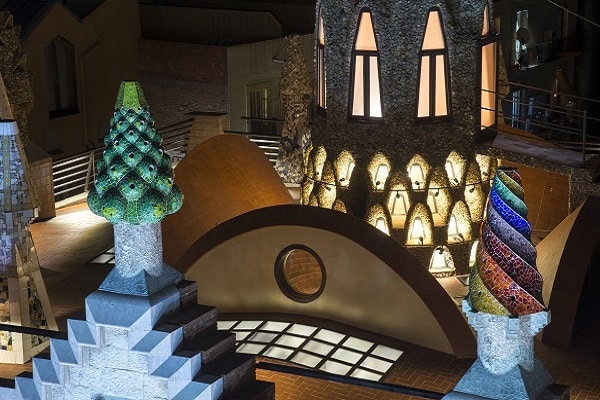In the old town of Barcelona, the Palau Güell, one of Antoni Gaudí’s first masterpieces, offers an unforgettable and exclusive experience with the night tour “The Secret Palau Güell”. This activity takes place on the second Saturday of every month, allowing attendees to explore the most hidden and unknown corners of this iconic building, which are normally closed to the public. During this special tour, visitors are immersed in the history and daily life of the influential Güell family, while enjoying the majesty of the palace in the twilight and without crowds.
 Secret Palau Güell
Secret Palau Güell
The visit “The secret Palau Güell” is much more than a simple architectural tour; it is an immersion in the atmosphere of Catalan modernism and the bourgeoisie of the late nineteenth century. From the beginning, the visitor has the possibility of accessing unusual places, such as the private office of Eusebi Güell, the powerful patron who commissioned the construction of this building to Gaudí. In addition, visitors can enjoy the sound of the palace organ, all from a private balcony, while music resounds in the majestic central hall.
The building was constructed between 1886 and 1890 as a multifunctional residence for the Güell family. Eusebi Güell lived in the palace with his wife, Isabel López, and their ten children, in an environment that reflected the power and prestige of one of the most influential families of the time. The wealth and luxury of this residence are evident in every detail, from the vaulted ceilings to the wooden floors, carefully designed to muffle the sound of the carriages and horses that entered the property.
Another perspective
One of the particularities of this visit is that it offers a new perspective of the already known spaces of the palace. For example, the rooftop, with its whimsical chimneys and vibrant colors, offers a panoramic view of Barcelona illuminated. This lends a touch of mystery and beauty to the nighttime experience. Specialized guides reveal anecdotes and secrets about Eusebi Güell, his close relationship with Gaudí and the hidden symbols that decorate the various rooms of the palace.
Among the unpublished spaces that can be visited is the coachman’s chamber, an area that had a dark past. During the postwar period, this 16-square-meter room was used as a dungeon by the police station of the Fifth District, one of the most conflictive areas of the city, popularly known as “Chinatown”. On the walls of this chamber, around 185 graffiti can be observed, made by the detainees of the time, which offer a moving testimony of the times of political repression. These engravings tell the story of those who were arrested, from anarchists and republican sympathizers to common criminals. Symbols of the CNT-AIT and the Spanish Falange can also be seen, reflecting the political tensions of the time.
On this visit, visitors can also appreciate Gaudí’s ability to play with light and shadow in his architecture, which creates a unique and magical atmosphere. The use of wrought iron and leaded glass, characteristic of the modernist style, stands out in every corner of the palace. The latticework of the windows, for example, allows you to see from the inside out, but not the other way around, adding a layer of mystery and privacy to the building.
Unique experience
The experience culminates in the central hall, a multifunctional space that once served as a reception hall, chapel and auditorium. The acoustics of this hall are unbeatable, and during the visit you can hear the sound of the organ, which enhances the majesty of the space. In addition, visitors have the opportunity to explore Eusebi Güell’s office, from where the entrepreneur oversaw his business and managed his impressive personal library.
The “Secret Palau Güell” tour is a unique experience designed for small groups of up to 12 people, which guarantees personalized attention and an in-depth tour of the history and secrets of the palace. This exclusive event not only allows visitors to rediscover Gaudí’s work from a new perspective, but also offers them the opportunity to immerse themselves in the cultural and social atmosphere of Barcelona at the end of the 19th century. A must-see for lovers of art, history and architecture.
Image courtesy of https://inici.palauguell.cat, all rights reserved.


 Secret Palau Güell
Secret Palau Güell
